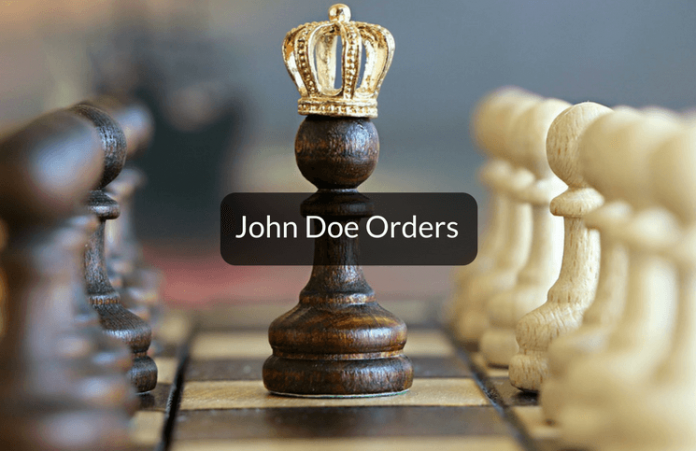This article is written by Sanjana Sen, pursuing a Diploma in Intellectual Property, Media and Entertainment Laws from Lawsikho.com. Here she discusses “Drafting an application for a John Doe order – Procedural requirements and Case laws”.

What is a John Doe Order?
A John Doe order is an anticipatory injunction sought against a person whose identity is not known at the time of order. It enables the right holders to issue notice and take action against anyone who is found infringing their Intellectual Property (IP).
For example: if A is suspicious that someone may infringe his IP in future that may result in huge losses for A, but is unknown of the name then A may apply for John Doe orders. Such orders are granted if the Judge is of the opinion that a considerable threat is there for which such an order is necessary.
Such an order is granted under Order 39 Rules 1 and 2 of the Code of Civil Procedure, 1908, which refer to the court’s power to grant a temporary injunction, read with Section 151 of the code, which provides for inherent powers of the court.
Background and Origin – John Doe Order
John Doe orders find its origin in the medieval age of British Monarchy, especially during the rule of King Edward III. It is said that during his rule, John Doe orders were used against unidentified persons. However, with rapid modernization and technological advancement, John Doe orders have come to the rescue of the right holders to save themselves from huge losses caused due to piracy. In this oceanic world of online platforms, it is very easy for anyone to copy someone’s work and make the work available to the public for free, which otherwise would have charged some fee and generated revenue for the right holders.
An order that is given out for males is known as John Doe and an order that is given out for females is known as Jane Doe orders. However, in India, we call it the Ashok Kumar order. One does not know how the name came to be used as a local substitute for John Doe but the name Ashok Kumar has gained popularity and legal acceptability in India.
John Doe order jurisprudence traces its origin in Taj Television Limited v. RajanMandal (2003 FSR 22), where Delhi High Court invoked its jurisdiction under section 151 of Civil Procedure Code (CPC) and issued a John Doe order against various cable operators to restrain unauthorized broadcast of the Football World Cup which was to be broadcasted then on Ten Sports Channel.
Ten Sports channel was the only channel then which broadcasted different sport matches, celebrity interviews, WWF matches, etc. Ten Sports channel had entered into agreements with various cable operators in order to make this channel available to the viewers so that revenue could be generated. The cable operators needed to pay a fee to the channel depending on the number of subscribers. And within no time, they started to illegally show the channel without giving the adequate fee to the channel. As soon as the owner of the channel got versed with this practice, he sued the cable operators and through his lawyer, prayed for John Doe order.
In order to obtain a John Doe order, the plaintiff needs to establish a prima facie case and show that actual irreparable harm will be caused if such order is not issued.

Procedural laws
There are certain provisions of Civil Procedure Code (CPC) that apply to John Doe suits which are essential to follow while drafting a John Doe suit so that it is admissible in the court.
Order I Rule 7: When the Plaintiff is in doubt as to whom he is entitled to seek redress from, he may mention two or more Defendants in order and the question that who can be held liable for the infringement and to what extent, which may be determined later.
Order I Rule 10(2): Court may strike out or add parties in the suit at any stage of the proceedings. If the court is of the opinion that (with or without the application of either of the party) few names have been improperly mentioned in the suit as plaintiff or defendant, then it may strike off the names. Similarly, if the Court is of the opinion that certain names are necessary to be mentioned in the suit and be admitted as a party, then it might add such names.
Order VI Rule 14A: Address for service of notice. Before filing the pleading in the court, the address of the parties shall be properly checked by the person filing the suit or by the pleader. All the court communications will be sent to the address mentioned in the suit (registered address) therefore, the party mentioning such address shall either be very sure of the address or state to the court its bonafide knowledge of the address if he is unsure of the same. In case the party comes to know about change in address, he shall lodge the same in the court through a form duly filled up, attached with the verified petition.
Order VII Rule 1: Particulars to be contained in plaint— Plaint shall contain the name, description and place of residence of the defendant, so far as they can be ascertained.
Order XXX Rule 1: Suing of partners in the name of the firm. The persons liable as partners of the firm, may sue or be sued in the name of the firm if such persons were partners at the time of accruing of the cause of action. And any party to the suit may apply to the court for the names and addresses of such persons who were partners at the time of accruing of cause of action.
Order XXX Rule 10: Suit may be filed against a person carrying on business in the name other than his own. Any person carrying on business in a name or style other than his own may be sued under that name or style under which the business is running as if it is the firm’s name. All rules under this order shall apply accordingly.
Section 20: Other suits to be instituted where defendants reside or cause of action arises.
John Doe suits may be filed where:
- the defendant or defendants, in case there are more than one defendant, resides or carries on business or works for gain;
- the defendant or defendants, in case there are more than one defendant, at the time of commencement of the suit, resides or carries on business or works for gain provided that in such case leave of the court is granted or in case where the defendant (s) do not reside or carry on business there but acquiesce with the institution; and
- cause of action, whether partially or wholly arises.
Case laws
- In UTV Software Communications Limited v. Home Cable Network Limited & Others (CS OS no. 821 of 2011, decided on April 2011), the Producer and distributor of several movies like ‘7 Khoon Maaf’ filed suit against several known and unknown cable operators who telecasted pirated version of the films of the Producer, causing irreparable loss to the Producer and thereby infringing his Intellectual Property. The court gave its decision in favour of the plaintiff and stated that unlicensed broadcast by the cable operators of the reproduction rights which vests with the Producer is illegal, unfair and deserves to be prohibited.
- In Reliance Big Entertainment v. Multivision Network Limited & Others (CS OS no. 1724/2011, decided on August 2011), the Producer (Plaintiff) of the film “Bodyguard” filed an interim application seeking for a John Doe order against unknown cable operators, based on his apprehension that the cable operators may infringe his broadcast rights and may telecast the film on television without acquiring proper rights from him. His apprehension was based on prior experiences and the growing technological advances that make everything available on the net. The Delhi High Court took cognisance of this fact and by accepting that such illegality should be prohibited, passed the order in favour of the plaintiff.
- In Red Chillies Entertainment Private Limited v. Hathway Cable Datacom Limited (Notice of Motion (L) no. 2366/2014 in Suit (L) no. 993/2014, decided in October 2014), the Plaintiff prayed for John Doe order against unknown persons who might infringe their copyright in the film “Happy New Year”. The apprehension of the Plaintiff was that there is a likelihood of pirated copies of this film being released on different media, including Blu-Ray, CD, DVD, VCD etc., and even of the film being transmitted through the service/es of various cable operators. The Bombay High Court acknowledged this fact and passed the restraining order against such persons and practices.
- In M/s SanDisk Corporation v. Ramjee & Others (CS OS no. 3205/2017, decided in May 2017), SanDisk Corporation (Plaintiff) which is world’s largest dedicated provider of flash memory storage solutions under the house mark SANDISK, filed a suit before the Delhi High Court against the defendants, whose exact identity was not known to the plaintiff. The plaintiff alleged that those unknown persons were selling counterfeit products with the identical name SanDisk, SanDisk Logo and with an identical packaging. The Plaintiff further stated that a large number of stalls were set up all across the pavements at Daryaganj to sell the counterfeit SanDisk Micro SD Memory Cards with an identical packaging as that of the plaintiff. The Delhi High Court, vide its order dated 17.10.2014 passed an ex-parte injunction against the unknown persons stating that the unnamed and undisclosed persons arrayed as “John Doe/s” are restrained from manufacturing, selling, offering for sale, advertising, directly or indirectly, dealing in counterfeit products, which are identical to the products bearing the plaintiff’s Trademark SanDisk and logo marks and the Red Frame logo, with identical product packaging, product get-up, colour scheme, layout, overall look and feel as that being used by the plaintiff. In 2017, the Plaintiff revisited the order and claimed for permanent injunction on such selling and manufacturing of goods and asked for Rs. 20 Lacs as damages from such unknown persons. The Court was pleased to grant permanent injunction and slapped Rs. 15 Lacs as damages to be paid to SanDisk Corporation by the John Doe(s).
Current scenario with John Doe Orders
In view of the above mentioned cases, it is understood that with the growing technological facilities, it is very easy to copy/ infringe the rights of the owners through various modes and platforms.
Piracy takes place either through satellite broadcast/ internet piracy or by using someone’s trade name or mark in manufacturing goods. John Doe suits have increased over the past few years due to piracy and copy of the original works of the owners and it continues to save the aggrieved as and when the situation arises. In order words, one can say that the John Doe order is a subset of copyright where the right owner can seek for an order restraining the “unknown defendants” from copying, distributing or publishing any original work of the right owner without his permission. And in recent times, where piracy is an easy task to do, John Doe orders are a boon to the right owners.
Students of Lawsikho courses regularly produce writing assignments and work on practical exercises as a part of their coursework and develop themselves in real-life practical skill.
LawSikho has created a telegram group for exchanging legal knowledge, referrals and various opportunities. You can click on this link and join:











